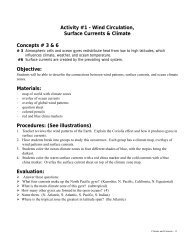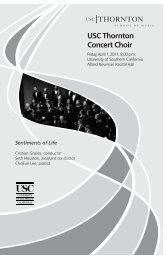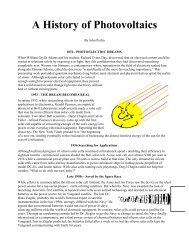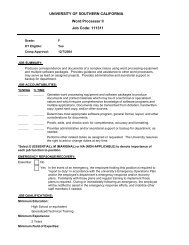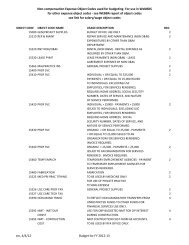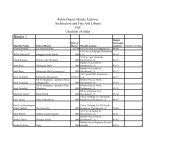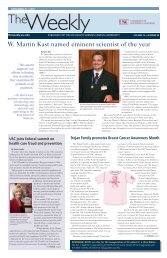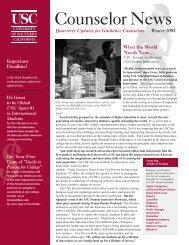A Profile of Financially At-Risk College Students
A Profile of Financially At-Risk College Students
A Profile of Financially At-Risk College Students
You also want an ePaper? Increase the reach of your titles
YUMPU automatically turns print PDFs into web optimized ePapers that Google loves.
56 THE JOURNAL OF CONSUMER AFFAIRSANGELA C. LYONSA <strong>Pr<strong>of</strong>ile</strong> <strong>of</strong> <strong>Financially</strong> <strong>At</strong>-<strong>Risk</strong> <strong>College</strong> <strong>Students</strong>Using a random sample <strong>of</strong> college students, this study identities the factorsthat significautly affect the probability a college student is financiallyat risk for tnismanaging/misusing credit. <strong>Financially</strong> at-risk studentsare more likely to be financially independent, to receiveneed-based financial aid, lo hold $1000 or more in other debt, and tohave acquired their credit card(s) by mail, at a retail store, and/or at acampus table. <strong>Students</strong> having difficulty making credit card paymentsare also more likely to be female, black, and/or Hispanic. Campus administratorsand financial pr<strong>of</strong>essionals can use this information to betterallocate their resources and develop materials that specifically targetthose students who need them most.In recent years, the dramatic growth in credit card usage among collegestudents has generated concern that students' credit card hehavior is puttingthem at greater risk for high debt levels and misuse and/or mismanagement<strong>of</strong> credit after graduation. Rising college costs and the recent economicslowdown have intensified these concerns.Several recent studies have attempted to determine whether college studentsare in fact incurring excessive amounts <strong>of</strong> credit card dehl (Allenand Jover 1997; Armstrong and Craven 1993; Baum and O'Malley 2003;The Education Resources Institute and the Institute for Higher EducationPolicy 1998; Hayhoe 2002; Hayhoe, Leach, and Turner 1999; Hayhoe,Leach, Turner. Bruin, and Lawrence 2000; Lyons and Andersen 2002;Joo, Grable. and Bagwell 2001; Staten and Barron 2002; U.S. GeneralAccounting Office 2001; Xiao, Noring. and Anderson 1995). These studiesexamine students' use <strong>of</strong> credit including: credit card ownership, theamount <strong>of</strong> credit card deht incurred, the types <strong>of</strong> credit cards held, and students'attitudes towards credit usage.In general, these studies find that while the majority <strong>of</strong> college studentsnow have credit cards, they appear to he using them responsibly and are notAngela C. Lyons is an Assistant Pr<strong>of</strong>essor in the Department <strong>of</strong> Agricultural and Consumer Economicsat the University <strong>of</strong> Illinois at Urbana-Champaign {anglyons@uiuc.edu). The author gratefullyacknowledges ihe assistance and support <strong>of</strong> Orlo Austin, the Director <strong>of</strong> the Oftice <strong>of</strong> Financial Aid,and Patricia Andersen. The author also thanks Dorothy Bagwell. Celia Rae Hayhoe. Robert Weagley,and Tanse! Yilmazer for their invaluable comments and support. An earlier version <strong>of</strong> this paper waspresented at the 2003 Annual Conference <strong>of</strong> the American Council on Consumer Interests.The Journal <strong>of</strong> Consumer Affairs, Vol. 38. No. 1. 2004ISSN 0022-0078Copyright 2004 by The American Council on Consumer Interests
SUMMER 2004 VOLUME 38, NUMBER 1 57accumulating large amounts <strong>of</strong> debt. The findings from these studies indicatethe following: approximately 70.0% <strong>of</strong> college students have at leastone credit card; the vast majority obtain credit cards prior to college or duringtheir freshman year; between 6.0% and 14.0% have four or more creditcards; over half <strong>of</strong> those with credit cards repay their balances in full eachmonth; and only 14.0% to 16.0% report balances over $1000 while about5.0% report balances over $3000.The findings from these studies suggest that growing concerns over risingcredit card debt levels <strong>of</strong> college students are likely to be unwarranted.These studies, however, acknowledge that there are some college studentswho do have excessive amounts <strong>of</strong> debt. These students are at risk <strong>of</strong> notbeing able to repay their debts, either because <strong>of</strong> a lack <strong>of</strong> financial experienceor a lack <strong>of</strong> funds. Unfortunately, these studies do not clearly identifywho these students are. There may be identifiable groups on collegecampuses that are more at risk than others for experiencing financial strain.These at-risk groups may have a need for specific financial education programsto ensure that they are not at a financial disadvantage and are able tomake informed financial decisions.What characteristics are associated with being financially at risk? Dothese characteristics vary by the measure <strong>of</strong> risk used? This study addressesthese issues and provides insight into what college administratorsand financial pr<strong>of</strong>essionals can do to help at-risk students better managetheir finances and repay their debts after graduation.LITERATURE REVIEWAs previously mentioned, several recent studies examine the behaviorand attitudes <strong>of</strong> students with respect to credit card usage. Armstrong andCraven (1993) were among the first to examine college students' credit usageand payment practices and to identify race and sex as significant predictors<strong>of</strong> the number <strong>of</strong> credit cards held. With respect to gender, theyfound that women were more likely than men to own credit cards. Women,however, carried lower balances. They argued that women may have a betterunderstanding <strong>of</strong> credit cards and their finances. With respect to race,they found that black students were less likely than white students to owncredit cards.Xiao, Noring, and Anderson (1995) were among the first to focus oncollege students' attitudes towards credit card usage. They found that studentswith "favorable" attitudes towards credit cards were more likely to bemale, living on campus, and majoring in consumer affairs. <strong>Students</strong> with
58 THE JOURNAL OF CONSUMER AFFAIRSfavorable attitudes were also more likely to own credit cards and/or phonecards, use credit cards more frequently, and have credit cards that were cosignedby their parents. They concluded that effective credit education programsneeded to find ways to change students' attitudes about credit so thatthey were more receptive to information on how to use credit responsibly.Joo, Grable, and Bagwell (2001) were also among those to examine thefactors associated with students' attitudes towards credit cards as well asstudents' actual credit card usage. Using a sample <strong>of</strong> 250 students from alarge university in a southwest state, they found the following: 70.7% <strong>of</strong>the students sampled had at least one credit card with more than 10.0%holding five or more cards; almost half <strong>of</strong> the students with credit cards(49.4%) paid their credit card bills in full each month; and 10.0% <strong>of</strong> thosewith credit cards made only the minimum payment each month. Positiveattitudes towards credit cards were found among those students whoowned a credit card(s), were white, were in a lower academic year, had parentswho used credit cards, and had parents who did not have credit-relatedproblems. Unlike Xiao, Noring, and Anderson (1995), they did not findgender, academic major, and living arrangements to be significant predictors<strong>of</strong> credit attitudes.A study by Hayhoe, Leach, and Turner (1999) used a 1997 sample <strong>of</strong>426 college students from five state universities. Using this sample, theyestimated an ordered logistic regression and identified the factors that affecta student's decision to hold 4 or more credit cards. <strong>Students</strong> with fouror more credit cards were significantly more likely to be female, to havetaken a personal finance course, to prepaie a list when shopping, and tohave had money used as a reward in their family. They were also significantlymore likely to feel an emotional "high" using credit cards and tothink more about the consequences <strong>of</strong> using credit. They were less likelyto borrow from friends or relatives.In the only longitudinal study to specifically examine college studentsand credit card usage, Hayhoe (2002) examines the credit usage <strong>of</strong> 120 collegestudents from six universities in the spring <strong>of</strong> 1997 and then followsup with these students in 1999. The results from the follow-up show that,for the most part, students were able to repay their debts after graduation.Only one student had defaulted on his or her student loans and three werebehind on rent/utility payments. Most students had decreased the number<strong>of</strong> credit cards they were holding. However, they increased the number <strong>of</strong>credit cards they were holding with an outstanding balance.Another recent study by Staten and Barron (2002) pooled a sample <strong>of</strong>300,000 active accounts randomly selected from the portfolios <strong>of</strong> five <strong>of</strong>
SUMMER 2004 VOLUME 38, NUMBER 1 59the top 15 general-purpose credit card issuers in the U.S. The accountswere opened hetween mid-1998 and early 2000 and were active for a 12-month period during 2000-2001. The study compared hehavior acrossthree types <strong>of</strong> credit card accounts: those opened through student marketingprograms, those opened by young adults 18-24 through conventionalmarketing programs, and those opened hy adults 25 or older through conventionalmarketing programs. They found that accounts marketed tocollege students had smaller halances and lower credit limits than conventionalaccounts that were opened by young adults and older account holders.In addition, student accounts were more likely to be delinquent and toresult in a charge-<strong>of</strong>f compared to the other accounts. However, the dollaramounts on delinquent accounts and the actual amounts charged-<strong>of</strong>f weresubstantially lower. According to the authors, the findings are consistentwith issuers' statements that students establish accounts with relativelylow credit limits with the expectation that the majority will learn how tomanage a credit card and establish a good credit history.Overall, the previous studies have significantly contributed to the literatureby laying a foundation for examining the credit card usage, attitudestowards credit, and fmancial knowledge and practices <strong>of</strong> college students.However, while these studies find that most college students use creditcards responsibly, there are some students whose credit card behavior putsthem at greater risk for high debt levels and misuse <strong>of</strong> credit after graduation.Previous studies do not clearly identify who these students are. In addition,there are doubts about the randomness <strong>of</strong> the samples used in many<strong>of</strong> these studies. Most, if not all, use data that was not randomly collectedand so the findings are based on select groups <strong>of</strong> students which calls intoquestion the reported findings.This study picks up where recent literature has left <strong>of</strong>f and uses a randomsample <strong>of</strong> college students at the University <strong>of</strong> Illinois to identify thecharacteristics <strong>of</strong> financially at-risk students and provide insight into howcollege administrators and financial pr<strong>of</strong>essionals can better address theirfinancial education needs. The findings from this study are <strong>of</strong> particularimportance given rising college costs and the recent economic slowdown,which have undoubtedly placed financial strain on many middle-to-lowincome students (Asin<strong>of</strong> and Chaker 2002; The Education Resources Instituteand The Institute for Higher Education Policy 1998; Lyons 2003;Shenk 1997; Rohrke 2002; U.S. General Accounting Office 2001). Inknowing which students are financially at risk, campus administrators andfinancial pr<strong>of</strong>essionals can better allocate their resources and develop materialsto specifically target those students who need them most.
60 THE JOURNAL OF CONSUMER AFFAIRSThe remainder <strong>of</strong> this paper is structured as follows. The next sectiondiscusses the methodology and empirical framework used to identifyfinancially at-risk college students. The third section describes the sample,and the fourth section presents the empirical findings. The final sectionsdiscuss and summarize the findings and explain in more detail the results<strong>of</strong> this study and why they are <strong>of</strong> particular importance and timeliness.METHODOLOGYTheoretical FrameworkTraditional life-cycle theory with budget constraints lends considerableinsight into why students borrow to finance their college education. Accordingto the theory, households are rational agents who form expectationsabout their future income and wealth holdings, borrowing againstthose expectations in order to smooth consumption over their life cycle.For college students, the level <strong>of</strong> debt incurred to finance their educationin the current and future periods is the optimal level <strong>of</strong> debt needed tomaintain their equilibrium position.Within this framework, some students may have every intention <strong>of</strong> repayingtheir debts when they are incurred. However, unforeseen events(i.e., an unexpected increase in tuition or living expenses, car repairs, ormedical expenses) may place them in a position where they are no longerable to meet their debt obligations. In these cases, students are unable torepay their current debts. The end result for these students may be delinquency,and in the most extreme cases, bankruptcy.For each student that applies for a credit card, a level <strong>of</strong> creditworthiness,C(Wi), is established. A student's level <strong>of</strong> creditworthiness is basedon a number <strong>of</strong> factors, W,, including the student's current income, expectedfuture income, wealth holdings, past credit history, and other demographics.Credit card companies use this measure <strong>of</strong> creditworthiness todetermine the amount <strong>of</strong> credit that will be extended to the student.Lender's reject a student's application when their level <strong>of</strong> creditworthinessfalls below some minimum level, C(M^y), such that C(W,) < C(W,). In thiscase, the student's default risk is so large that the lender is unwilling to extendcredit under any circumstances. Lenders extend credit when C{W^ ^C(W,). However, the credit limit that is approved and the rate <strong>of</strong> interest andfees the student must pay depend entirely upon their level <strong>of</strong> creditworthiness,C{W,). Lenders will approve larger amounts <strong>of</strong> credit at lower rates<strong>of</strong> interest for students whose C{W^) is farther away from QW^. <strong>At</strong> the
SUMMER 2004 VOLUME 38. NUMBER 1 61same time, lenders will charge higher rates <strong>of</strong> interest and extend smalleramounts <strong>of</strong> credit to students whose C(W/) is closer to or equal to C(Wi).The closer CiWj) is to C{Wj)., the more vulnerable the student is to unexpectedfinancial distress and the more likely they are to niisuse/mismanagetheir credit and default.Misuse and/or mismanagement <strong>of</strong> credit further lowers a student's level<strong>of</strong> creditworthiness. <strong>Students</strong> with low levels <strong>of</strong> creditworthiness typicallyhave lower credit scores because they hold large balances, are delinquenton their payments, have reached the limit on their cards, and/or are havingdifficulty paying their balances in full. Thus, these financially at-risk studentshave certain identifiable characteristics that make them more likelythan others to accumulate high interest payments and large amounts <strong>of</strong>credit card debt. The next section presents the empirical models for beingfinancially at risk and identifies the factors that are likely to contribute tomisuse and/or mismanagement <strong>of</strong> credit. These factors also affect an individual'slevel <strong>of</strong> creditworthiness.The Empirical ModelFor the purposes <strong>of</strong> this study, students are identified as being financiallyat risk if they have one or more <strong>of</strong> the following four characteristics:1) have credit card balances <strong>of</strong> $1000 or more, 2) are delinquent on theircredit card payments by two months or more, 3) have reached the limit ontheir credit cards, and 4) only pay <strong>of</strong>f their credit card balances some <strong>of</strong> thetime or never.The measures <strong>of</strong> financial risk were constructed based on previous researchwhich has consistently identified credit misuse and/or mismanagementaccording to these four characteristics (i.e., Baum and O'Malley2003; The Education Resources Institute and The Institute for HigherEducation Policy 1998; U.S. General Accounting Office 2001). Thesemeasures clearly identify students who are having difficulty managingtheir credit and/or repaying their credit card balances and allow for comparisonsto more easily be made across studies. Each measure captures aslightly different aspect <strong>of</strong> financial risk—the magnitude <strong>of</strong> how much isowed, the ability to make timely payments, future ability to borrow, and theability to repay debts incurred. <strong>Students</strong> who are classified as financially atrisk may have one or more <strong>of</strong> these characteristics. The next sectionidentifies the students who fall into each <strong>of</strong> these categories.To identify the factors that affect the probability <strong>of</strong> being financially atrisk, probit models are estimated for each <strong>of</strong> the four at-risk behaviors
62 THE JOURNAL OF CONSUMER AFFAIRSmentioned above. The relationship is assumed to be as follows for the firstmodel:(1) Z)> - X,'^, -\- M, where D; = 1 if D,* ^ 1000and 0 otherwise for i = {1 I}.D, is the discrete dependent variable that is equal to one if the /''' studentholds credit card balances <strong>of</strong> $1000 or more and zero otherwise. D, is determinedhy the continuous, latent variable D,*, the actual amount <strong>of</strong> creditcard deht held hy the student.The factors that determine D,*, and thus D,, are represented hy the vectorXj. Included in X, are factors that are used to control for other types <strong>of</strong>credit usage and financial behavior including: whether the student is financiallyindependent; whether the student receives needs-based financial assistance;whether the student has $ 1000 or more in other debt such as a carloan, mortgage, or other private loan; and how the student acquired theircredit card(s) (by mail, at a bank/financial institution, at a retail store,and/or at a campus table). It is important to note that some <strong>of</strong> these factorsmay he endogenous. However, due to data limitations, it is not feasible toconstruct instruments to control for the possibility <strong>of</strong> endogeneity. Therefore,it is assumed that these values have been exogenously determined.In addition to the factors previously mentioned, the vector X, also controlsfor student demographics such as gender, ethnicity, marital status,hours worked per week, the population <strong>of</strong> the urban or rural area where thestudent attended their senior year <strong>of</strong> high school, whether they are a graduatestudent, whether they rent an apartment <strong>of</strong>f campus, and whether theyare likely to budget their money every month. Other variables in the vectorX, are used to control for a student's attitudes towaids credit usage.Specifically, students were asked whether they believed it was all right toborrow money or use a credit card to pay for spring break or other vacations,to buy a car or make car payments, to pay for educational expenses,to pay for entertainment, and/or to use for shopping.The error terms, H,, are assumed to be distributed standard normallywith mean zero and variance o", equal to one. The prohit method is used t<strong>of</strong>ind consistent estimates <strong>of</strong> equation (1). The probit method is also used toidentify the factors that determine the probability that a student is 1) delinquenton their credit card payments hy two months or more, 2) reaches thelimit on their credit cards, and 3) only pays <strong>of</strong>f his or her credit card balancessome <strong>of</strong> the time or never. In all three cases, the likelihood functionsfor each <strong>of</strong> the prohit models are estimated and consistent estimates <strong>of</strong> theregressors are obtained.
SUMMER 2004 VOLUME 38, NUMBER 1 63SAMPLEThe Office <strong>of</strong> Student Financial Aid (OSFA) conducted an online surveyin the fall <strong>of</strong> 2001 to examine the credit usage <strong>of</strong> undergraduate andgraduate students at the University <strong>of</strong> Illinois. A random sample <strong>of</strong> 2,650students (approximately 7.0% <strong>of</strong> the total student population) was selectedfrom the University's database to electronically receive the survey. Thesample included undergraduate and graduate and pr<strong>of</strong>essional students.The survey was posted on the web at the beginning <strong>of</strong> November. <strong>At</strong> thistime, an email message with a formal description <strong>of</strong> the survey and a linkto the survey's URL was sent to the random sample. Between November9th and December 9th, 2001, the OSFA sent out a total <strong>of</strong> four mass e-mails to the random sample. <strong>Students</strong> who completed the survey weregiven the option to participate in a prize drawing for a $150 bookstorevoucher. Five vouchers were awarded, the winners being randomly selectedfrom a pool <strong>of</strong> students who chose to submit their email address toparticipate in the drawing. For a more detailed description <strong>of</strong> the surveymethodology used to conduct this online study, see Lyons and Andersen(2002) and Lyons, Cude, Lawrence, and Gutter (2003).A total <strong>of</strong> 915 students responded to the survey (a response rate <strong>of</strong>34.0%). However, <strong>of</strong> the 915 students who responded to the survey, only835 were valid responses. Eighty student observations had to be droppedprimarily due to missing information. Observations were also removed becausea few students submitted their survey information more than once orsubmitted blank surveys.It should be noted that the sample used for this study includes both undergraduatestudents and graduate and pr<strong>of</strong>essional students. Both groupsare included in the sample primarily because <strong>of</strong> the small sample size andthe small cell sizes that result if only undergraduate students are included.This may be viewed as a limitation <strong>of</strong> the study since there are some identifiabledifferences in the credit usage <strong>of</strong> undergraduate and graduate students.For example, graduate students are more likely to owe more creditcard debt but less likely to mismanage/misuse credit. However, it can alsobe viewed as a contribution to the literature since very little work has focusedon the credit usage <strong>of</strong> graduate students.The tables that follow provide an overview <strong>of</strong> the demographic andfinancial characteristics <strong>of</strong> the sample. Findings are presented for studentswith credit cai-ds, students with credit cards and no at-risk characteristics,and students with credit cards and at least one at-risk characteristic. Informationis also presented according to the four at-risk characteristics: credit
64 THE JOURNAL OF CONSUMER AFFAIRScard debt ^$1000, delinquent on credit card payments, reached the limiton their credit cards, and only paid <strong>of</strong>f credit card balances some <strong>of</strong> thetime or never.Of the 835 students who comprise the working sample, 78.8% reporthaving at least one credit card. Of those with a credit card, 47.0% indicatethat they engage in at least one <strong>of</strong> the four at-risk behaviors. About44.0% <strong>of</strong> at-risk students report engaging in only one at-risk behavior (themajority not paying their bills in full each month), and 33.3% report engagingin two at-risk behaviors (primarily holding balances over $1,000and not paying bills in full each month). Almost 16.0% <strong>of</strong> at-risk studentshave three <strong>of</strong> the four at-risk characteristics, and only 6.8% report all fourcharacteristics.The first column in Table 1 provides general demographic informationon the entire student sample used in this study regardless <strong>of</strong> at-riskstatus. Almost 55.0% <strong>of</strong> the students are female and 10.7% are married.With respect to ethnicity, 69.9% are white, 5.3% are black, 15.2% areAsian, and 5.1% are Hispanic. With respect to year in school, 20.0% arefreshmen, 14.0% are sophomores, 16.5% are juniors, 22.9% are seniors,and 26.6% are graduate students. Over half <strong>of</strong> the students in the sample(55.0%) rent an apartment and 70.1 % budget their money every month. Inaddition, over half <strong>of</strong> the students (55.7%) are working either on or <strong>of</strong>fcampus. The majority <strong>of</strong> students in the sample (61.2%) lived in a city witha population <strong>of</strong> 20,000 or more during their senior year in high school.The sample <strong>of</strong> students used in this study is fairly representative <strong>of</strong> thecampus population as a whole witb tbe exception that there appears to bean oversampling <strong>of</strong> female students. Campus statistics for 2002 indicatethat 47.0% <strong>of</strong> the total student body is female, 6.9% is African-American,13.1% is Asian, 5.8% is Latino, and 25.4% report being graduate students.The remaining columns in Table I focus on the demographics <strong>of</strong> studentsaccording to their financial risk status. The findings reveal that studentswith credit cards who exhibit at-risk behaviors are more likely thanstudents with credit cards who do not exhibit at-risk behaviors to be female,married, black, Hispanic, and/or to be renting an apartment. Theyare also more likely than other students to be college seniors and graduateor pr<strong>of</strong>essional students. Interestingly, students who are delinquent ontheir credit card payments by two months or more are more likely to be female.With respect to employment, students witb credit cards who exhibitat-risk behaviors are more likely to be working and to be working morehours per week than the entire sample <strong>of</strong> students. While the results are
Q •§ —y I I,vq — -^ in(N 00 ri-i d~ — — (M~ rn rj -*o? ~=^3; ,213 mQ\ o o 00 rN r^ r^Tf d r~^ in ri — d—11—t i—I f^i r^t -^ V^cin in d ^ \D—. (N _ _in' oin r~a 2•^1•^ - ^ s•-'^ounCQ5
66 THE JOURNAL OF CONSUMER AFFAIRSsomewhat mixed with respect to regional information, financially at-riskstudentsaremorelikely to have lived in a city with a population <strong>of</strong> 100,000or more during their senior year in high school.Table 2 summarizes tbe credit cbaracteristics <strong>of</strong> the entire sample andcompares them to those who have been identified as financially at risk. Asmentioned previously, 78.8% <strong>of</strong> the total number <strong>of</strong> students who weresampled report holding at least one credit card. About 15.0% report holding4 or more credit cards. With respect to credit card balances, the firstcolumn <strong>of</strong> Table 2 shows that 15.7% <strong>of</strong> the students sampled indicate thatthey owe $1000 or more in credit card debt and 7.3% owe $3000 or more.The majority <strong>of</strong> students (69.6%) report paying <strong>of</strong>f their balances in lulleach month. However, 15.2% reached the borrowing limit on their cardsalmost every month, and 7.5% have been delinquent on their credit cardpayments by two months or more. With respect to their ability to obtaincredit, 23.2% report that they have been rejected or turned down by a creditcard company. These findings are consistent with the literature suggestingthat the credit practices <strong>of</strong> students at the University <strong>of</strong> Illinois are similarto those <strong>of</strong> other college campuses.Compared to tbe entire sample, financially at-risk students are significantlymore likely to hold 4 or more credit cards and to owe more than$3000 in credit card debt. <strong>Financially</strong> at-risk students are also much morelikely to reach the borrowing limit on their credit cards, he delinquent ontheir payments, and/or be rejected for a credit card. They are less likely tobe ahle to pay <strong>of</strong>f their balances in full each month. These findings shouldnot be surprising since many <strong>of</strong> these characteristics are being used toidentify those at financial risk.Other characteristics that appear to play a key role in whether a studentis financially at risk include whether or not the student is financially independent;receives some type <strong>of</strong> need-based financial assistance includingneed-based grants, financial aid loans, and/or federal work study; and/orowes $1000 or more in other debt including car loans, mortgages, andother personal loans. According to Table 2, students' attitudes towards usingcredit appear to contribute very little to a student's likelihood <strong>of</strong> mismanaging/misusingcredit. However, a key characteristic that appears todetermine financial risk is related to how students acquire their creditcard{s). <strong>Financially</strong> at-risk students are more likely than the entire sampleto acquire their credit card{s) through a mail application, at a retail store,and/or at a campus table.It is important to point out that in the survey students were asked to reportall the ways in which they had acquired their credit card(s): in the
a. cO UOS O O 00Ovo — ovri p — »-^ CT>d r-^ Tf — rjf". rs 00 'J- •*ID tst —O -^ O(N O^ O — — 00p O p r-ld ci d —c-i 00 a^— r^ d-I so in< -2a c5?5-? w 'H 2 — pc
68 THE JOURNAL OF CONSUMER AFEAIRSmail, at a retail store, at a financial institution/bank, at a campus table, overthe phone, or completing an application online. Since students could selectmore than one choice, the percentages do not sum to 100%. Only the topfour choices <strong>of</strong> how students acquired their credit card(s) are reported inthe tables (in the mail, at a retail store, at a financial institution/bank, at acampus table). The other two categories (over the phone and completingan online application) are omitted from the tables. The percentages <strong>of</strong> studentswho indicated that they acquired their credit card(s) by completingan online application or over the phone were 10.3 and 5.2%. respectively.Overall, this initial investigation <strong>of</strong> the data provides insight into thefactors that may explain why some college students are at greater financialrisk than others. Those factors that are likely to be significant contributorsto whether a student is financially at risk include gender, ethnicity, being agraduate student, being financially independent, receiving financial assistance,owing other debt, and whether the credit card(s) is acquired in themail, at a retail store, or at a campus table. The next step is to see if the regressionresults support these preliminary findings.RESULTSThe results from the probit models are presented in Table 3. Four probitmodels have heen estimated to determine the factors that significantly affectthe probability a student 1) holds $1000 or more in credit card debt,2) is delinquent on credit card payments by two months or more, 3) hasreached the limit on his or her credit cards, and 4) only pays <strong>of</strong>f credit cardbalances some <strong>of</strong> the time or never.For each model, students without credit cards and those with creditcards who are not classified as being financially at risk are grouped togetherand compared to those who are classified as being financially at risk.Researchers may be concerned that differences in the hehavior and characteristics<strong>of</strong> those without credit cards and those with credit cards mayexist among those who are not financially at risk. Two-stage probit estimationmodels that correct for sample selection reveal that the characteristics<strong>of</strong> the two groups are very similar, and excluding students withoutcredit cards from each model does not significantly affect the results. Theappendix presents the probit estimates for only those students that reportedhaving a credit cai"d. The two-stage estimates are available from the authorupon request.
SUMMER 2004 VOLUME 38, NUMBER I 69Model 1: Credit Card Balances <strong>of</strong> $1000 or MoreThe first two columns in Table 3 present the marginal effects and standarderrors from the prohit model for the prohability a student holds $1000or more in credit card debt. As hypothesized, students who receive someTABLE 3Prohit Models for Probability Student Is <strong>Financially</strong> <strong>At</strong>-<strong>Risk</strong>Groups <strong>of</strong> <strong>At</strong>- <strong>Risk</strong> Student;Credit card debt ^$1000Delinquent on paymentsVariableMESEMESE<strong>Financially</strong> independentReceives financial aidOther debt >$1000FemaleBlackAsianHispanicGraduate studentMarriedRents an aparlmentBudgets moneyWorks l-9hrs/wkWorks 10-15 hrs/wkWorks 16-20 hrs/wkWorks >20 hrs/wkTown/city (pop 2,500-20.000)City (pop 20.000-99.999)City (pop 100,000 or more)Acquired card in tnailAcquired card at bankAcquired card at retail storeAcquired card at campus tableAH right to borrow for vacationAll right to borrow for carAll right to borrow for educationAil right to borrow for entertainmentAll right to borrow for shopping0.01200.04630.0825-0.02820,1644-0.0343-0.01210.05820.07190.0652-0.03840.04160.03050.06710.0697-0.0512-0.00560.02260.09560.00250.11080.05810.0015-0.0370-0.0104-0.02140.0076(0.0300)(0.0234)*'(0.0319)***(0.0215)(0.0799)***(0.0269)(0.0433)(0.0397)*(0.0476)*(0.0224)***(0.0248)*(0.0370)(0.0333)(0.0506)(0.0470) *(0,0301)**(0.0301)(0.0296)(0.0229)***(0.0262)(0.0352)***(0.0403)*(0.0268)(0-0223)*(0.0355)(0.0305)(0,0316)0.05440.00190.03690.02730.1528-0-00950-0964-0.03940.01300.04160,0073-0,0.352-0.02070.0305-0.01670.01550-00360.03770.02930,01170,02150,07400,0043-0.0204-0.02220.0107-0.0196(0-0235)***(0-0132)(0.0199)**(0.0123)**(0.0716)***(0,0170)(0.0541)***(O.OL^S)"*(0.0239)(0.0139)***(0,0141)(0.0122)**(0.0133)(0.0290)(0.0172)(0-0309)(0.0196)(0.0219)**(0.0148)**(0,0173)(0,0199)(0,0344)***(0,0163)(0.0136)(0.0255)(0.0176)(0.0167)ObservationsNo. <strong>of</strong> positive observationsR'8351310.2400835630-2222Note: ME represents the marginal effects for the probit model. Standard errors for the marginaleffects are indicated by ( ). Omitted categories include "not working" and living in a "rural area(pop
70 THE JOURNAL OF CONSUMER AFFAIRSTABLE 3 (continued)Probit Models for Prohahility Student Is <strong>Financially</strong> <strong>At</strong>-Ri.skGroups ot <strong>At</strong>-<strong>Risk</strong> Student!Reached limiton credit cardsDo not paybalance in fullVariableMFSEMFSF<strong>Financially</strong> IndependentReceives financial aidOiher debt >$ 1000FemaleBlackAsianHispanicGraduale studentMarriedRents an apartmentBudgets moneyWorks l-9hrs/wkWorks 10-15 hrs/wkWorks 16-20 hrs/wkWorks > 20 hrs/wkTown/city (pop 2.500-20.000)City (pop 20.000-99.999)City (pop 100,000 or more)Acquired card in mailAcquired card al bankAcquired card ai retail storeAcquired card al campus tahleAll righl to borrow for vacationAll right to borrow for carAll righl to borrow for educationAll righl to borrow for entertainmentAll righl to borrow for shopping0.07640.04460.13860.00170.03630.0314-0.0093-0.09230.05680.0341-0.0383-0.0222-0.02880.02520.0339-0.0456-0.0199-0.03990.07780.05860.04960.12320.0323-0.05320.0155-0.0240-0.0024(0.0363)**(0.0256)*(0.0365)***(0.0235)(0.0564)(0.0367)(0.0485)(0.0275)***(0.0513)(0.0251)(0.0268)(0.0317)(0.0296)(0.04.53)(0.0476)(0.0347)(0.0308)(0.0281)(0.0249)***(0.0335)*(0.0337)(0.0479)***(0.0291)(0.0236)**(0.0346)(0.0335)(0.0348)0.09840.14510.1191-0.00920.2624^ 0.0662O.07190.05920.00260.1126-0.05650.02750.07430.17840-10430.00780.07530.06280.10490.01810.13770.1427-0.0322-0.02690.0459-0.02980.0390(0.0485)**(0-0357)***(0.0453)***(0.0342)(0.0878)***(0.0462)(0.0874)(0.0555)(0.0607)(0.0354)'**(0.0372)(0.0515)(0.0520)(0.0685)***(0.0655)*(0.0650)(0.0520)(0.0471)(0.0346)***(0.0439)(0.0461)***(0.0587)***(0.0411)(0.0362)(0.0510)(0.0524)(0-0528)ObservationsNo. <strong>of</strong> positive observationsR^8351270.14758352540.1887Note: ME represents the marginal effects for the probii model. Standard errors for the marginalefFects are indicated by ( ). Omitted categories include "not working" and living in a "rural area(pop
SUMMER 2004 VOLUME 38, NUMBER 1 71by 4.6 percentage points while holding some type <strong>of</strong> other debt greaterthan or equal to $1000 increases a student's probability by 8.3 percentagepoints. Being financially independent does not appear to significantly affectthe probability <strong>of</strong> holding a substantial credit card balance.Other factors that significantly increase a student's probability <strong>of</strong> holding$1000 or tnore in credit card debt include being black, being a graduatestudent, being married, renting an apartment, working more than 20hours per week, and having acquired a credit card through the mail, at a retailstore, or at a campus table. Of these, the factor that appears to have thelargest effect is being black, which increases the probability <strong>of</strong> holding asubstantial credit card balance by 16.4 percentage points.The findings also show that students who lived in a town/city with apopulation that was between 2,500 or 20,000 during their senior year inhigh school are less likely to hold substantial credit card balances thanthose who lived in a rural area with a population <strong>of</strong> less than 2,500. In addition,students who indicate that they budget their money every month areless likely to bold $1000 or more in credit card debt. However, thesignificance <strong>of</strong> these findings is fairly weak and the findings do not bold upacross the other models.Model 2; Delinquent on Credit Card PaymentsThe second set <strong>of</strong> columns in Table 3 present the marginal effects andstandard errors from the probit model for the probability a student is delinquenton their credit card payments by two months or more. These studentsare perhaps the most at risk since they clearly have difficulty managingtheir credit and making payments. The findings from this model confirmmany <strong>of</strong> those generated by the first model. Owing $1000 or more in otherdebt significantly increases the probability <strong>of</strong> being delinquent by twomonths or more by 3.7 percentage points. Being black also significantly increasestbe probability by 15.3 percentage points. In addition, renting anapartment and acquiring credit cards through a mail application or at acampus table also increase the probability <strong>of</strong> delinquency. Unlike the previousmodel, receiving financial aid does not significantly affect the probability<strong>of</strong> delinquency while being financially independent does by 5.4 percentagepoints. In addition, being a graduate student decreases theprobability <strong>of</strong> delinquency whereas being female and Hispanic increasethe probability by 2.7 and 9.6, respectively.
72 THE JOURNAL OE CONSUMER AEEAIRSModel 3: Reached Limit on Their Credit CardsSimilar trends can be found in tbe data with respect to the probit modelfor the probability students have reached the limit on their credit cards.The third set <strong>of</strong> colutnns in Table 3 indicate that being financially independent,receiving financial aid, and owing $ 1000 or more in other debt increasethe probability <strong>of</strong> maxing out credit cards by 7.6, 4.5, and 13.9, respectively.Acquiring a credit card in the mail, at a bank, or at a campustable also increase the probability a student maxes out their credit cards by7.8, 5.9, and 12,3, respectively. Gender and ethnicity do not appear to playa significant role in this model. However, being a graduate student decreasesthe probability by 9.2 percentage points. This finding may be an indicationthat while graduate students have more debt, they may be more responsibleabout repayment. This finding may also refiect the fact tbatgraduate students are able to acquire more credit cards with higher creditlimits making them less likely to reach the borrowing limit on their cardsthan undergraduates. However, while more credit cards with higher limitsmay not put graduate students at risk for maxing out their credit cards, itdoes put them at greater risk for acquiring large balances, which was foundin the first model.Model 4: Does Not Pay Credit Card Balances in FullThe final set <strong>of</strong> columns in Table 3 show which factors affect a student'sprobability <strong>of</strong> only paying <strong>of</strong>f their credit card balances some <strong>of</strong> the timeor never. As in the previous models, being financially independent, receivingfinancial aid, and owing $1000 or more in other debt increase theprobability <strong>of</strong> not paying balances in full each month. Being black, rentingan apartment, and working 16 or more hours per week also increase theprobability. As revealed by the other three models, the way in which studentsacquire their credit card(s) plays a key role in whether or not they arefinancially at risk. Acquiring a credit card in the mail, at a retail store, or ata campus table increases the probability a student only pays <strong>of</strong>f his or hercredit card balances some <strong>of</strong> the time or never.DISCUSSIONOverall, the findings provide substantial insight into tbe characteristics<strong>of</strong> financially at-risk students and tbe reasons why some students are atgreater risk for mismanaging and misusing credit. The findings from tbe
SUMMER 2004 VOLUME 38, NUMBER I 73four models are fairly consistent in that those students who are havingdifficulty managing their credit card debt are having financial difficultiesin general. As the results indicate, those who hold large credit card balancesare more likely to hold other types <strong>of</strong> debt and receive need-basedfinancial aid. They are also more likely to have little or no financial supportfrom their parents (i.e., those who are financially independent and/orworking 16 or more hours per week). These findings support concernsraised hy Zhou and Su (2000) who indicate that students with lower familyincomes are likely to have higher student loan amounts and credit carddebt than students from families with higher incomes.The findings suggest that the rising costs <strong>of</strong> obtaining a college educationmay be playing a key role in the rise <strong>of</strong> credit usage on college campuses(Asin<strong>of</strong> and Chaker 2002; The Education Resources Institute andThe Institute for Higher Education Policy 1998; Lyons 2003; Shenk 1997;Rohrke 2002; U.S. General Accounting Office 2001). Lyons (2003) indicatesthat almost 50.0% <strong>of</strong> students receiving financial assistance do notfeel that the amounts they are receiving are enough to cover college costs.Current levels <strong>of</strong> financial assistance may not be enough to cover the risingcosts <strong>of</strong> college. Those students most in need <strong>of</strong> financial assistancemay he forced to work more than 20 hours per week and to turn to otherforms <strong>of</strong> horrowing such as credit cards to complete their college degree.In the end, those who are likely to be at greatest financial risk may be lowto-middleincome students.All four models also indicate that how students acquire their credit cardshas a significant effect on the amount <strong>of</strong> credit card debt incurred as wellas a student's ahility to repay those balances. <strong>Financially</strong> at-risk studentsare more likely than other students to acquire their credit card(s) through amail application, at a retail store, and/or at a campus table. These findingssuggest that aggressive marketing practices by credit card companies totarget college students (i.e., mass mailings, retail store discounts, andcredit card representatives on campus) have likely contributed to the recentrise in credit card debt on college campuses putting some students at morefinancial risk than others.Finally, it is interesting to note that those groups who have traditionallyhad difficulty obtaining credit (i.e., women, minorities, and low-income individuals)are also more likely to be at financial risk. In particular, thosestudents who are delinquent on their credit card payments are more likelyto be female, black, and/or Hispanic. Black students are also significantlymore likely to have credit card balances <strong>of</strong> $1000 or more and to not paytheir balances in full, suggesting a general need for financial education.
74 THE JOURNAL OF CONSUMER AFFAIRSWomen and Hispanics do not appear to be at risk with respect to theamounts <strong>of</strong> credit card debt held and being overextended. However, theirinability to make payments on time suggests that these groups may needinformation on the factors that affect an individual's credit rating as well asthe importance <strong>of</strong> building a good credit history.The bottom line is that these findings indicate a need for financial educationprograms that specifically target financially at-risk groups such aslow-to-middle income students, women, and minorities to ensure that theyare not at a financial disadvantage. What types <strong>of</strong> financial services d<strong>of</strong>inancially at-risk students find useful?On the Office <strong>of</strong> Student Financial Aid (OSFA) survey, students wereasked about their need for campus financial services. Specifically, they wereasked if they would use the following financial services if made availableon campus: pamphlets and informational handouts on money managementand credit card debt; self-help online information on money managementand credit card debt; seminars/workshops on money management andcredit card debt; and counseling services concerning money managementand credit card debt. Table 4 presents the findings for all students, studentswith credit cards and no al-risk behaviors, and students with credit cardsand at least one at-risk behavior. (Note that students could select more thanone financial service so the percentages do not sum to 100%.)Three findings are <strong>of</strong> particular interest. First, at-risk students are morelikely than non at-risk students to use financial services, and they prefer toaccess financial information online. Table 4 shows that financially at-riskstudents ranked online information on money management as their firstchoice, online information on credit card debt as their second choice, andmaterials on money management as their third choice. However, thesefindings may be due to sample selection bias since online methods wereused to collect the data.Second, regardless <strong>of</strong> the mode <strong>of</strong> delivery, at-risk students prefer to receiveinformation on money management rather than credit card debt. Thisfinding may be due to the wording <strong>of</strong> the survey questions. Perhaps, if thesurvey had asked students about "credit card management" rather than"credit card debt," students would have indicated that they would beequally likely to use services related to both credit card debt and moneymanagement.Third, and perhaps most importantly, at-risk students who report beingdelinquent on their credit card payments by two months or more appear tobe more likely than other at-risk groups to use some type <strong>of</strong> financial serviceif <strong>of</strong>fered by the University. Overall, these findings begin to provide
^ .2o ^I< -3ElingS -3ing!cardo•§uCOvith-asentdenlditrE S 2 51 ^1 S I00 _aII E E == £ O
76 THE JOURNAL OF CONSUMER AFFAIRSinsight into the types <strong>of</strong> services and programs that college campuses andother organizations may want to <strong>of</strong>fer to assist students who are financiallyat risk.CONCLUSIONSUsing data from a random sample <strong>of</strong> college students at the University<strong>of</strong> Illinois, this study has identified and characterized those students atgreatest financial risk for mismanaging/misusing credit. Prohit modelswere estimated to determine which factors significantly affect the prohabilitya student 1) holds $ 1000 or more in credit card deht, 2) is delinquenton credit card payments by two months or more, 3) has reached the creditlimit on his or her credit cards, and 4) only pays <strong>of</strong>f credit card balancessome <strong>of</strong> the time or never.The results indicate that financially at-risk students are more likely thanothers to be financially independent, to receive need-based financial assistance,to hold $1000 or more in other types <strong>of</strong> debt, and to have acquiredtheir credit card(s) by mail, at a retail store, and/or at a campus table. <strong>Students</strong>who are having difficulty making credit card payments are morelikely to be female, black, and/or Hispanic. Black students are also significantlymore likely to have credit card balances <strong>of</strong> $ 1000 or more and to notpay their balances in full each month. Also, at-risk students are more likelythan non at-risk students to prefer receiving financial information onlineand in the form <strong>of</strong> pamphlets and informational handouts rather than seminars,workshops, and/or counseling services.These findings have clear implications for educational outreach and policyon college campuses nationally. <strong>Financially</strong> at-risk groups (i.e., studentsfrom low-to-middle income families, financially independent students,and minorities) are likely to have specific financial education needswith respect to programs and services. Campus administrators and financialpr<strong>of</strong>essionals can use the findings from this study to begin identifyingwhich students are most likely to have specific financial education needs.In knowing which students are financially at risk, campus administratorsand financial pr<strong>of</strong>essionals can better allocate their resources and developprograms and services to specifically target those students most at risk.These resources can better help students build financial knowledge, makeinformed financial decisions, use financial services responsibly, and developmenta sense <strong>of</strong> financial independence.Given the rising costs <strong>of</strong> a college education and the recent economicslowdown, it has become even more important that financially at-risk stu-
SUMMER 2004 VOLUME 38, NUMBER I 77dents receive the appropriate financial interventions so they are not at afinancial disadvantage when they graduate. Targeted financial educationprograms are likely to result in fewer payment problems, defaults, andcharge-<strong>of</strong>fs after graduation.In addition to identifying the characteristics associated with financialrisk, this study also provides insight into how financial strain may be affectingcampus retention rates and which students are likely to be affected.This study points out that students who owe larger balances on their creditcards are significantly likely to borrow more in financial aid. Thus, thosestudents most in need <strong>of</strong> financial assistance may be forced to turn to otherforms <strong>of</strong> borrowing such as credit cards to complete their college degree.Campus administrators and financial pr<strong>of</strong>essionals can use this informationto lobby policy makers and lending agencies to improve the currentfinancial aid system so that it better meets the needs <strong>of</strong> those students mostaffected by the rising costs <strong>of</strong> a college education.In the end, this study provides significant insight into which studentsmay be financially at risk and how campus administrators and financialpr<strong>of</strong>essionals can better help these students manage their credit and avoidfuture misuse <strong>of</strong> credit down the road. However, the research is far fromcomplete and three areas in particular need further investigation.First, research is needed to investigate the ability <strong>of</strong> recent college graduatesto manage their credit card burdens after graduation, especially giventhe rise in the number <strong>of</strong> bankruptcies for those under 25 years <strong>of</strong> age (U.S.General Accounting Office 2001; Asin<strong>of</strong> and Chaker 2002; Rohrke 2002).Longitudinal studies are needed to examine the long-run implications <strong>of</strong>debt accumulation and the role that credit card debt plays in the postcollegelives <strong>of</strong> students, especially their ability to repay their debts.Future research is also needed to examine the dynamics between alltypes <strong>of</strong> debt, in particular the causal relationship between credit card debtand financial aid loans. Lyons (2003) is already investigating whether studentsare charging more on their credit cards, because financial aid is notenough to cover rising college costs or because they want to consume moreand maintain a certain standard <strong>of</strong> living. However, research in this area isstill in the investigative stages and more detailed analysis needs to be conductedbefore our understanding is complete.Finally, research is needed to examine the long-term effects that financialeducation programs and services have on the ability <strong>of</strong> financially atriskstudents to manage their credit cards and repay their debts. Programsand services that specifically target financially at-risk students do not currentlyexist, and thus we are unahle to show whether financial education is
78 THE JOURNAL OF CONSUMER AFFAIRSeffective at changing these students' behavior both before and after graduation.The bottom line is that more longitudinal research is needed to addressthe long-run consequences <strong>of</strong> credit card usage and the impact <strong>of</strong>financial education on the financial well-being <strong>of</strong> college students, especiallythose who are financially at risk.APPENDIXPROBIT RESULTS FOR STUDENTS WITH CREDIT CARDSGroups <strong>of</strong> Al <strong>Risk</strong> Student;Credit card debt ^$1000Delinquent on paymentsVariableMESEMESE<strong>Financially</strong> independentReceives financial aidOther debi >$1000FemaleBlackAsianHispanicGraduate studentMarriedRents an apartmentBudgets moneyWorks 1-9 hrs/wkWorks lO-l? hrs/wkWorks 16-20 hrs/wkWorks >20 hrs/wkTown/city {pop 2.500-20,000)City (pop 20.000-99.999)City (pop 100.000 or more)Acquired card in maiiAcquired card at bankAcquired card at retail storeAcquired card at campus tableAll right lo borrow for vacationAll right to borrow for carAll right lo borrow for educationAll right to borrow for entertainmenlAll right to borrow for shopping0.01940.07120.1090-0.04220.2160-0.05470.00780.07590.08140.0834-0.05460.05860.03130.06370-0897-0.0791-0.02160.01310.0727-0.03830.12360-04810.0142-0.0378-0-0063-0-04670.0152(0,0424)(0.0324)**(0.0405)***(0.0298)(0.1013)***(0.0367)(0.0689)(0.0505)(0.0579)(0.0299)***(0.0342)*(0.0517)(0.0434)(0.0616)(0.0590)*(0.0410)(0.0403)(0.0395)(0.0296)**(0.0326)(0.0397)***(0.0463)(0.0356)(0.0311)(0.0490)(0.0428)(0.0438)0.0750O00430.04890.03770.2111-0.01440.1631-0.05950.01030-0484-O0078-0.0505-O32300-0302-O02380.0213-0.0018O04290.0106-O00540.0213O0705O0046-O0233-O0297O0063-O0247(0.0315)***(0.0190)(0.0260)**(0.0177)**(0.0976)***(0.0238)(0.0783)***(0.0211)**(0.0309)(0.0176)***(0.0197)(0.0177)**(0.0189)(0,0364)(0.0248)(0.0422)(0.0261)(0.0285)*(0.0190)(0.0218)(0.02-34)(0.0374)**(0.0220)(0.0194)(0 360)(0.0238)(0.0240)ObservationsR-6580.192965801926
SUMMER 2004 VOLUME 38, NUMBER I 79PROBIT RESULTS FOR STUDENTS WITH CREDIT CARDS (continued)Groups <strong>of</strong> <strong>At</strong> <strong>Risk</strong> <strong>Students</strong>Reached limiton credit cardsDo not paybalance in fullVariableMESBMESE<strong>Financially</strong> independentReceives linancial aidOther debt ^$] 000FemaleBlackAsianHispanicGraduale studentMarriedRents an apartmentBudgets moneyWorks l-9hrs/wkWorks 10-15 hrs/wkWorks 16-20 hrs/wkWorks >20 hrs/wkTown/city (pop 2.500-20.000)City (pop 20.000-99.999)City (pop lOO.WX) or more)Acquired card in mailAcquired card at bankAcquired card at retail storeAcquired card at campus tableAll right to borrow for vacationAll right to borrow for carAll right to borrow for educationAll right to borrow for entertainmentAll right to borrow for shopping0.12710.06250.18100.00450.08730.03140.0167-0.13840.03810.0180-0.0518-0.0358-0.05010.01520.0343-0.0648-0.0387-0.06570.01910.01180.03920.10810.0424-0.04900.0096- O.{)541-0.0019(0.0477)***(O.O338J*(0.0445)***(0.0314)(0.0852)(0.0456)(0.0723)(0.0378)***(0.0581)(0.0331)(0.0351)(0.0427)(0.0378)(0.0544)(0.0579)(0.0458)(0.0401)(0.0367)*(0.0320)(0.0380)(0.0379)(0.0515)**(0.0368)(0.0314)(0.0483)(0.0438)(0.0459)0.15810.20830.1463-0.02110.3755-0.10460.17810.0456-0.04000.1022-0.07440.02860.06370.16690.1163-0.00470.05630.0347-0.0493-O.llll0.10710.0803-0.04690.01410.0443-0.09300.0559(0.0597)***(0.043!)***(0.0516)***(0.0426)(0.0952)***(0.0551)*(0.1107)*(0.0643)(0.0686)(0.0441)**(0.0460)(0.0641)(0.0610)(0.0755)**(0.0723)*(0.0785)(0.0613)(0.0558)(0.0450)(0.0480)**(0.0490)**(0.0610)(0.0485)(0.0459)(0.0676)(0.0633)(0.0645)ObservationsR=6580,1202658O.t695Note: ME represents the marginal effects for the probit model. Standard errors for the marginaleffects are indicated by (•). Omitted categories include "not working" and living in a "rural area(pop
THE JOURNAL OF CONSUMER AFFAIRSREFERENCESAllen, Judy L. and Margaret A. Jover. 1997. Credit Card Behavior <strong>of</strong> University <strong>Students</strong>: Ethnic Differences.Consumer ItileresI Annual. 43: 162-170.Armstrong, Connie J. and M. Joyce Craven. 1993. Credit Card Use and Payment Practices Among <strong>College</strong><strong>Students</strong>. Proceedings <strong>of</strong> the 6th Annual Conference <strong>of</strong> the Association for Financial Counselingand Ptanning Ethicalion, 148-159.Asin<strong>of</strong>. Lynn and Marie A. Chaker. 2002. <strong>College</strong> Planning: Families Scramble to Pay Tuition: <strong>College</strong>sBegin Offering New Aid. The Wall Street Journal. July 18.Baum. Sandy and Marie O'Malley. 2003. <strong>College</strong> on Credit: How Borrowers Perceive Their EducationDebt. 2002 National Student Loan Survey, Nellie Mae Corporation, http://www.nelliemae.com/library/nasls_2002.pdf.The Education Resources Institute and The Institute for Higher Education Policy. 1998. Credit <strong>Risk</strong> orCredit Worthy? <strong>College</strong> <strong>Students</strong> and Credit Cards. Boston, MA.Hayhoe, Celia. 2002. Comparison <strong>of</strong> Affective Credit <strong>At</strong>titude Scores and Credit Use <strong>of</strong> <strong>College</strong> <strong>Students</strong>at Two Points in Time. Journal <strong>of</strong> Family and Consumer Sciences. 94: 71 -77.Hayhoe, Celia. Lauren Leach, and Pamela Turner. 1999. Discriminating the Number <strong>of</strong> Credit CardsHeld by <strong>College</strong> <strong>Students</strong> Using Credit and Money <strong>At</strong>titudes. Journal <strong>of</strong> Economic Psychology, 20:643-656.Hayhoe. Celia, Lauren Leach, Pamela Turner. Marilyn Bruin, and Frances Lawrence. 2000. Differencesin Spending Habits and Credit Use <strong>of</strong> <strong>College</strong> <strong>Students</strong>. Journal <strong>of</strong> Consumer Affairs, 34:113-133.Joo, So hyun. John Grablc, and Dorothy Bagwell. 2001. <strong>College</strong> <strong>Students</strong> and Credit Cards. Proceedings<strong>of</strong> the Association for Financial Counseling and Planning Education, 8-15.Lyons, Angela. 2003. The Credit Usage and Financial Education Needs <strong>of</strong> Midwest <strong>College</strong> <strong>Students</strong>.University <strong>of</strong> Illinois at Urbana-Champaign, report.Lyons, Angela and Patricia Andersen. 2002. Credit Usage <strong>of</strong> <strong>College</strong> <strong>Students</strong>: Evidence from the University<strong>of</strong> Illinois. University <strong>of</strong> Illinois, report released April 2002.Lyons, Angela, Brenda Cude, Frances Lawrence, and Michael Gutter. 2003. The Challenges <strong>of</strong> OnlineSurveying: What Should Researchers Know? Working paper.Roberts, James and Eli Jones. 2001. Money <strong>At</strong>titudes, Credit Card Use, and Compulsive BuyingAmong American <strong>College</strong> <strong>Students</strong>. The Journal <strong>of</strong> Consumer Affairs. 35:213 -240.Rohrkc, Andrea. 2002. A Closer Look at Personal Finance. Econ Ed & the Fed. The Federal ReserveBank <strong>of</strong> San Francisco. Spring: 1 -3.Shenk, Joshua W. 1997. In Debt All Ihe Way Up to Their Nose Rings. U.S. News & World Report,June 9: 38-39.Staten. Michael and John Barron, 2002. <strong>College</strong> Student Credit Card Usage. Credit Research Center.Working Paper ^65. Georgetown University.U.S. General Accounting Office. 2(X)L Consumer Finance: <strong>College</strong> <strong>Students</strong> and Credit Cards. Reportto Congressional Requesters (GAO 01 773).Xiao, Jing, Franziska Noring, and Joan Anderson. 1995. <strong>College</strong> <strong>Students</strong>' <strong>At</strong>titudes Towards CreditCards. Journal <strong>of</strong> Consumer Studies and Home Economics. 19: 155-174.Zhou, Li and Hung-Jen Su. 2000. Predicting <strong>College</strong> Student Debt: An Exploratory Study on Sociodemographic,Economic, <strong>At</strong>titudinal, and Behavioral Determinants. Proceedings <strong>of</strong> the Associationfor Financial Counseling and Planning Education. 133-140.



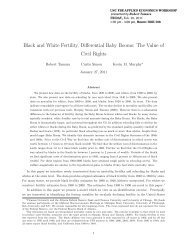

![15. RS 1.003 (RaJsu-yeni - nql?) RS 18.056 (RaJsu-yeni -5'[ ... ])](https://img.yumpu.com/51622603/1/189x260/15-rs-1003-rajsu-yeni-nql-rs-18056-rajsu-yeni-5-.jpg?quality=85)
